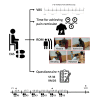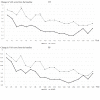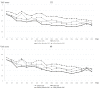Efficacy of Electronic Acupuncture Shoes for Chronic Low Back Pain: Double-Blinded Randomized Controlled Trial
- PMID: 33104004
- PMCID: PMC7652696
- DOI: 10.2196/22324
Efficacy of Electronic Acupuncture Shoes for Chronic Low Back Pain: Double-Blinded Randomized Controlled Trial
Abstract
Background: Chronic low back pain is a common problem and is associated with high costs, including those related to health care and indirect costs due to absence at work or reduced productivity. Previous studies have demonstrated that acupuncture or electroacupuncture can relieve low back pain. Electronic acupuncture shoes (EAS) are a novel device designed in this study. This device combines the properties of acupuncture and transcutaneous electrical nerve stimulation for clinical use.
Objective: The aim of this study was to evaluate the efficacy of EAS in patients with chronic low back pain.
Methods: In this prospective double-blinded randomized controlled study, the data of 83 patients who experienced chronic low back pain were analyzed. Patients came to our clinic for 20 visits and underwent assessment and treatment. Patients were randomly allocated to receive either EAS plus placebo nonsteroidal anti-inflammatory drugs (NSAIDs) (EAS group, n=42) or sham EAS plus NSAIDs (NSAID group, n=41). The visual analog scale (VAS) score and range of motion were assessed at baseline, before and after each EAS treatment, and 2 weeks after the last treatment. The time for achieving pain remission was recorded. Quality of life was assessed at the 2nd, 14th, and 20th visits.
Results: After 6 weeks of treatment, the treatment success rate in each visit in the EAS group was higher than that in the NSAID group, as revealed by the intention-to-treat (ITT) and per-protocol (PP) analyses, but significant differences were observed only during the 16th visit in the ITT analysis (EAS group: 31/37, 84% and NSAID group: 21/34, 62%; P=.04). The change in the VAS score from baseline in each visit in the EAS group was greater than that in the NSAID group, as revealed by the ITT and PP analyses, and significant differences were observed in the 5th visit and 9th visit in the ITT analysis (P=.048 and P=.048, respectively). Significant differences were observed in the left rotation in the 2nd visit and 4th visit (P=.049 and P=.03, respectively). No significant differences were observed in the VAS score before and after treatment in each visit and in the quality of life in both groups.
Conclusions: EAS might serve as a reliable alternative therapeutic tool for patients with chronic low back pain who are contraindicated for oral NSAIDs.
Trial registration: ClinicalTrials.gov NCT02468297 https://clinicaltrials.gov/ct2/show/NCT02468297.
Keywords: acupuncture; electronic acupuncture shoes; low back pain; mHealth; medical device; self-treatment.
©Bo-Yan Yeh, Geng-Hao Liu, Tzung-Yan Lee, Alice May-Kuen Wong, Hen-Hong Chang, Yu-Sheng Chen. Originally published in the Journal of Medical Internet Research (http://www.jmir.org), 26.10.2020.
Conflict of interest statement
Conflicts of Interest: None declared.
Figures





Similar articles
-
Efficacy and safety of electromagnetic acupuncture using an electromagnetic therapy stimulator (Whata153) for the treatment of chronic low back pain: Study protocol for a single-center, parallel-arm, randomized clinical trial.Medicine (Baltimore). 2018 Nov;97(44):e13047. doi: 10.1097/MD.0000000000013047. Medicine (Baltimore). 2018. PMID: 30383673 Free PMC article. Clinical Trial.
-
Efficacy and safety of thread embedding acupuncture combined with conventional acupuncture for chronic low back pain: A study protocol for a randomized, controlled, assessor-blinded, multicenter clinical trial.Medicine (Baltimore). 2018 May;97(21):e10790. doi: 10.1097/MD.0000000000010790. Medicine (Baltimore). 2018. PMID: 29794761 Free PMC article. Clinical Trial.
-
Bee venom acupuncture for the treatment of chronic low back pain: study protocol for a randomized, double-blinded, sham-controlled trial.Trials. 2013 Jan 14;14:16. doi: 10.1186/1745-6215-14-16. Trials. 2013. PMID: 23317340 Free PMC article. Clinical Trial.
-
Low-level laser therapy for chronic non-specific low back pain: a meta-analysis of randomised controlled trials.Acupunct Med. 2016 Oct;34(5):328-341. doi: 10.1136/acupmed-2015-011036. Epub 2016 May 20. Acupunct Med. 2016. PMID: 27207675 Free PMC article. Review.
-
Acupuncture for the Management of Low Back Pain.Curr Pain Headache Rep. 2021 Jan 14;25(1):2. doi: 10.1007/s11916-020-00919-y. Curr Pain Headache Rep. 2021. PMID: 33443607 Review.
Cited by
-
Glucose deprivation-induced disulfidptosis in human nucleus pulposus cells: a novel pathological mechanism of intervertebral disc degeneration.Biol Direct. 2024 Sep 12;19(1):81. doi: 10.1186/s13062-024-00528-4. Biol Direct. 2024. PMID: 39267140 Free PMC article.
-
The effectiveness of non-pharmacological interventions for low back pain in China: A systematic review and network meta-analysis.PLoS One. 2025 May 9;20(5):e0322929. doi: 10.1371/journal.pone.0322929. eCollection 2025. PLoS One. 2025. PMID: 40343982 Free PMC article.
-
Neuropathic Pain Creates Systemic Ultrastructural Changes in the Nervous System Corrected by Electroacupuncture but Not by Pregabalin.J Pain Res. 2021 Sep 14;14:2893-2905. doi: 10.2147/JPR.S322964. eCollection 2021. J Pain Res. 2021. PMID: 34548816 Free PMC article.
-
Exercise Therapy Research in Ankylosing Spondylitis-Induced Back Pain: A Bibliometric Study (2004-2023).Med Sci Monit. 2024 Feb 13;30:e943196. doi: 10.12659/MSM.943196. Med Sci Monit. 2024. PMID: 38347712 Free PMC article.
-
Garments and Footwear for Chronic Pain.Front Pain Res (Lausanne). 2021 Oct 25;2:757240. doi: 10.3389/fpain.2021.757240. eCollection 2021. Front Pain Res (Lausanne). 2021. PMID: 35295438 Free PMC article.
References
-
- Qaseem A, Wilt TJ, McLean RM, Forciea MA, Clinical Guidelines Committee of the American College of Physicians Noninvasive Treatments for Acute, Subacute, and Chronic Low Back Pain: A Clinical Practice Guideline From the American College of Physicians. Ann Intern Med. 2017 Apr 04;166(7):514–530. doi: 10.7326/M16-2367. - DOI - PubMed
-
- Chen W, Fu G, Shen W. [Progresses of studies on acupuncture analgesia for postoperative reaction] Zhen Ci Yan Jiu. 2013 Feb;38(1):83–7. - PubMed
Publication types
MeSH terms
Associated data
LinkOut - more resources
Full Text Sources
Medical
Miscellaneous

